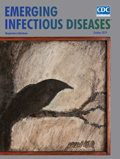
Volume 25, Number 10—October 2019
Letter
Self-Flagellation as Possible Route of Human T-Cell Lymphotropic Virus Type 1 Transmission
To the Editor: Blood donors in Australia who test positive for transfusion-transmissible infections, including human T-lymphotropic virus (HTLV), hepatitis B virus (HBV), hepatitis C virus, and HIV, undergo posttest counseling, as previously described (1). Similar to Tang et al. (2), we identified self-flagellation as a possible unique risk factor for HTLV-1 infection. History of self-flagellation was elicited in 7 (28%) of 25 HTLV-1–positive donors identified during January 2012–December 2018. All 7 donors were men 20–37 years of age, of whom 5 were born in Pakistan and 2 in India; 6 had given blood in Victoria, Australia. The 18 remaining HTLV-1–positive donors were 29–68 years of age; 10 (56%) were men; 1 was born in India and none in Pakistan; and 7 (39%) gave blood in Victoria.
HBV shares transmission routes with HTLV-1 and is highly infectious, including through minor blood exposures (3). After discussion of recognized infective risk factors, the 610 HBV-positive donors from the same period, of whom 83 were born in India or Pakistan, were asked about any other potential blood exposures. None reported self-flagellation.
At the time of posttest counseling, no previous HTLV results were available for donors reporting self-flagellation or for their family members. Until the known modes of vertical and sexual transmission have been excluded by such results, the likelihood of self-flagellation as an infective risk factor remains unclear. Although India and Pakistan are not known to be geographic risk areas for HTLV-1, few prevalence studies are available (4), and HTLV-1 is commonly present in small geographic foci (5). In addition, a noticeable degree of transmission through communal self-flagellation would first require a raised prevalence of infection among the practicing group. We look forward to further research that may clarify the apparent link between self-flagellation and HTLV-1 infection.
Acknowledgment
Australian governments fund the Australian Red Cross Blood Service for the provision of blood, blood products, and services to the Australian community.
References
- Polizzotto MN, Wood EM, Ingham H, Keller AJ; Australian Red Cross Blood Service Donor and Product Safety Team. Reducing the risk of transfusion-transmissible viral infection through blood donor selection: the Australian experience 2000 through 2006. Transfusion. 2008;48:55–63.
- Tang AR, Taylor GP, Dhasmana D. Self-flagellation as possible route of human T-cell lymphotropic virus type-1 transmission. Emerg Infect Dis. 2019;25:811–3.
- Trépo C, Chan HL, Lok A. Hepatitis B virus infection. Lancet. 2014;384:2053–63.
- Niazi SK, Bhatti FA, Salamat N. Seroprevalence of human T-cell lymphotropic virus-1/2 in blood donors in northern Pakistan: implications for blood donor screening. J Coll Physicians Surg Pak. 2015;25:874–7.
- Gessain A, Cassar O. Epidemiological aspects and world distribution of HTLV-1 infection. Front Microbiol. 2012;3:388.
Original Publication Date: 9/4/2019






















.png)











No hay comentarios:
Publicar un comentario